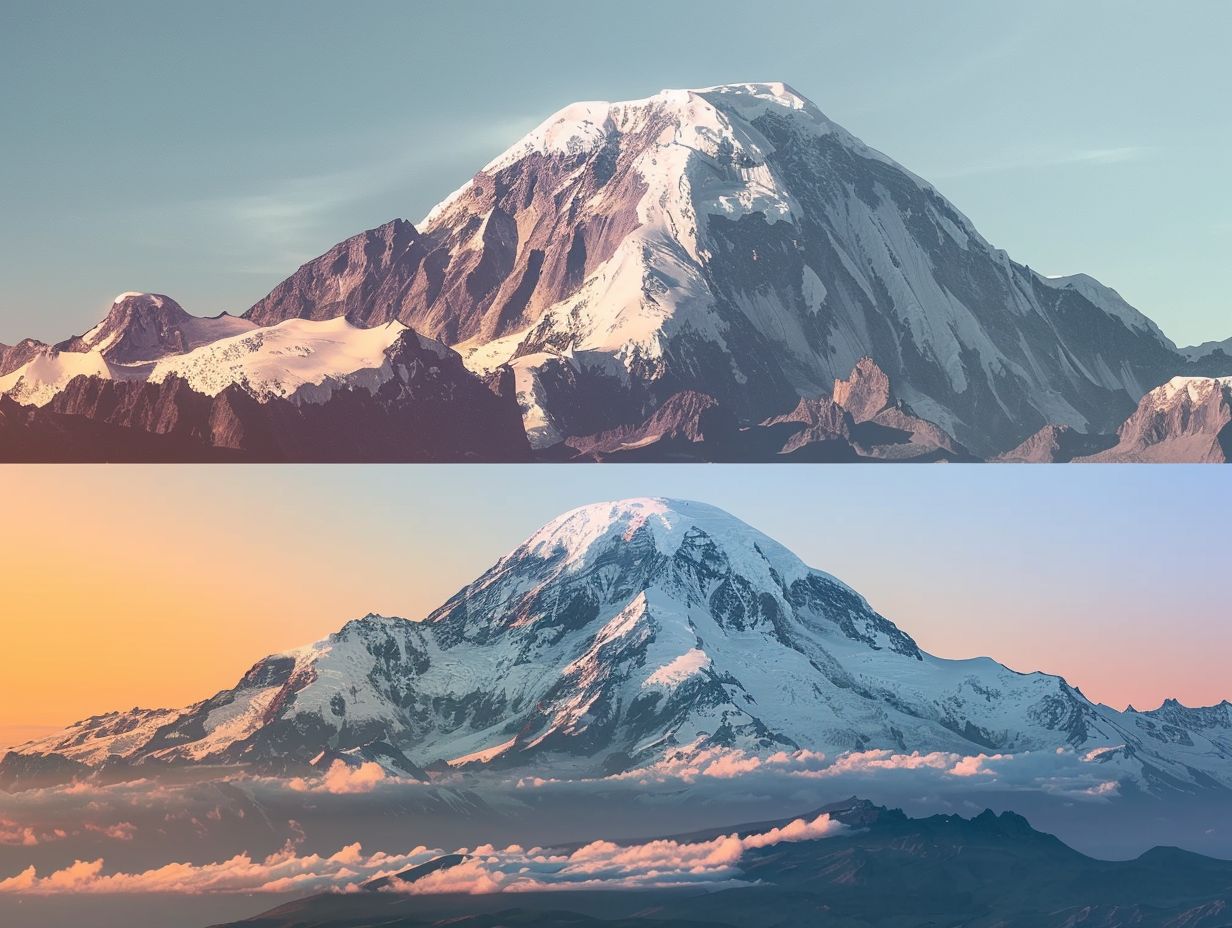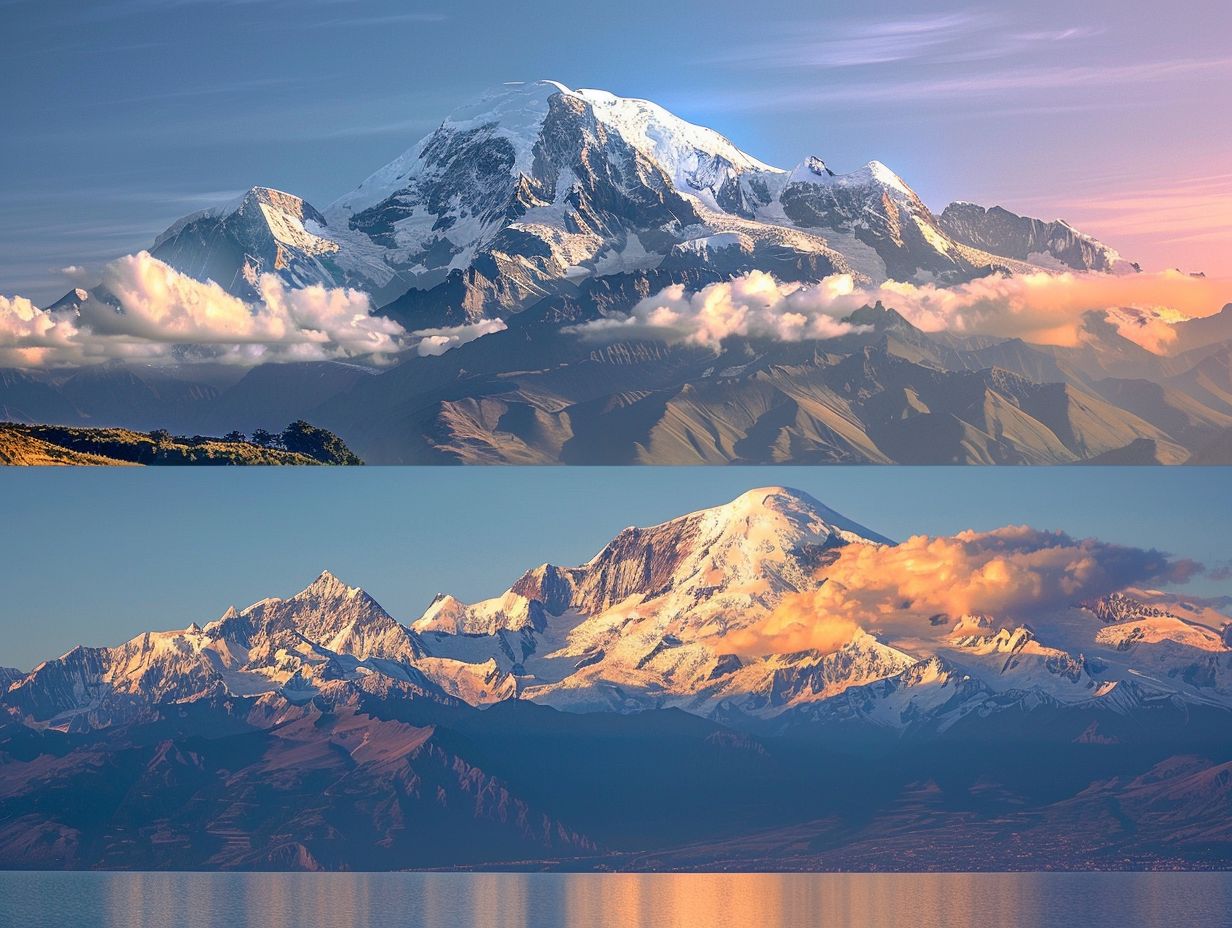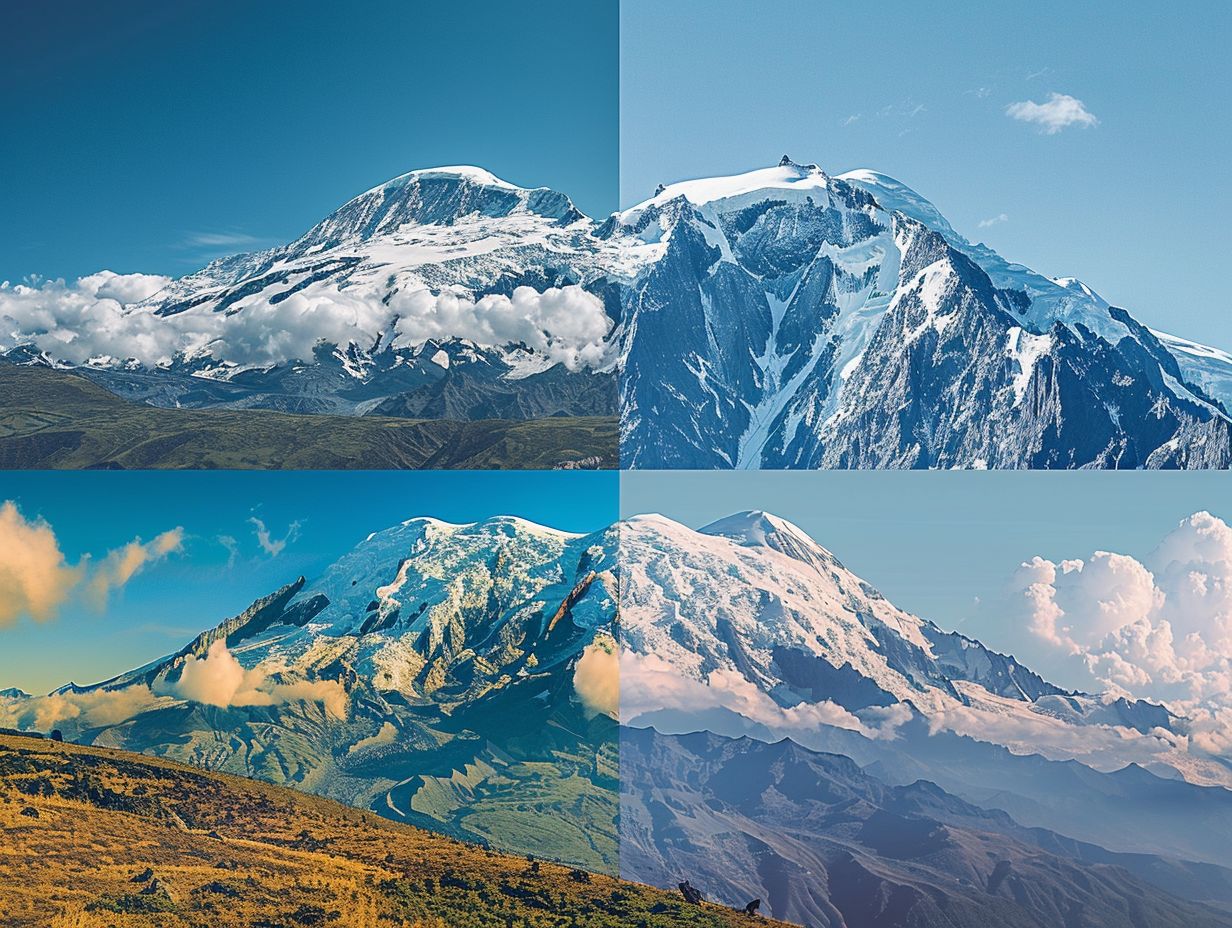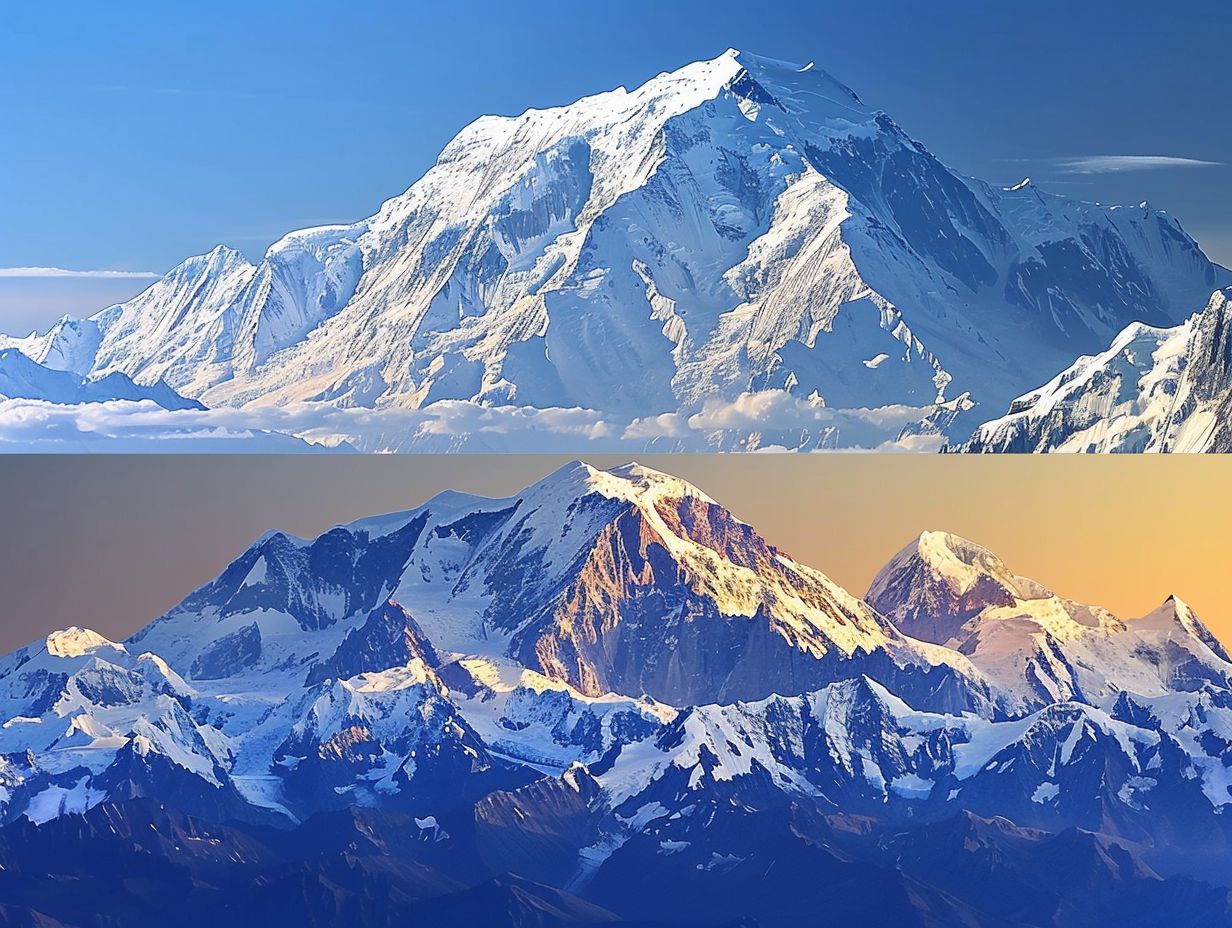
Kilimanjaro Vs Mount Blanc
Are you an adventurous soul looking to conquer towering peaks?
We compare two iconic mountains – Kilimanjaro and Mount Blanc. We explore the geographical differences, cultural and historical significance, trekking and climbing routes, accommodations, fitness and training requirements, as well as safety and emergency protocols for each mountain.
Whether you are a seasoned climber or a novice trekker, this article will provide valuable insights to help you plan your next mountain adventure.
Key Takeaways:

- Kilimanjaro and Mount Blanc differ in location, height, climate, and terrain, making each climb a unique experience.
- Both mountains hold cultural and historical significance, with indigenous people and explorers leaving their mark on the treks.
- Proper preparation is crucial for a safe and successful climb, including physical fitness and knowledge of emergency protocols.
Geographical Differences:
The geographical differences between Mont Blanc in Europe and Kilimanjaro in Africa are stark and intriguing.
Mont Blanc, located in the French Alps, rises to an impressive height of 4,810 meters above sea level and is known for its picturesque snow-covered peaks.
Its summit offers breathtaking views of Chamonix Valley and the surrounding mountain ranges.
On the other hand, Kilimanjaro, located in Tanzania, boasts a towering height of 5,895 meters and is famous for its distinct snow-capped summit, Uhuru Peak.
The mountain showcases a remarkable ecological diversity, starting from lush rainforests at its base to arid alpine deserts near the top.
-
Location and Height:
Mont Blanc, situated in the European Alps, is the highest peak in Europe, reaching an impressive altitude of 4,808 meters. On the other hand, Kilimanjaro, located in Africa, stands as the continent’s highest mountain, towering at 5,895 meters above sea level.
Mont Blanc’s prominence in the European landscape is marked by its staggering height, making it a popular destination for climbers and tourists alike. Its snow-capped peak offers breathtaking views of the surrounding region.
In contrast, Kilimanjaro’s height makes it a prominent feature in the African continent, attracting adventurers from all over the world seeking to conquer its challenging summit. The distinct characteristics of these two majestic mountains make them iconic landmarks within their respective continents.
-
Climate and Weather:
The climate and weather conditions on Mont Blanc and Kilimanjaro vary significantly due to their distinct geographic locations. Mont Blanc experiences alpine weather patterns, characterized by rapid changes in conditions and varying climate zones as climbers ascend. In contrast, Kilimanjaro showcases diverse climate zones, from lush rainforests at lower elevations to freezing temperatures near the summit.
These differing environments provide unique challenges for climbers on each mountain. Mont Blanc’s rapidly changing weather can bring sudden storms and extreme cold, posing risks to those attempting the ascent.
On the other hand, Kilimanjaro’s varying climate zones require climbers to adapt to different conditions as they progress through the rainforest, heath, moorland, alpine desert, and arctic summit zones.
-
Terrain and Difficulty:
The terrain and difficulty levels differ markedly between Mont Blanc and Kilimanjaro, with Mont Blanc offering challenging alpine terrain, including steep rock faces and treacherous ice crevices that test climbers’ skills. In contrast, Kilimanjaro presents a trekking challenge with high altitude and icy paths, making it more accessible to climbers with varying experience levels.
Mont Blanc, located in the French Alps, stands at 4,809 meters above sea level, requiring technical climbing skills due to its glacier-filled crevasses and unpredictable weather conditions. Climbers tackling Mont Blanc navigate through crevices and seracs, often roped together for safety in steep sections.
Conversely, Kilimanjaro in Tanzania reaches 5,895 meters and poses altitude-related challenges, often leading to altitude sickness if not acclimatized properly. The icy trails of Kilimanjaro, though less technical than Mont Blanc, demand endurance and proper preparation to tackle the height and cold.
Cultural and Historical Significance:
Both Mont Blanc and Kilimanjaro hold immense cultural and historical significance, deeply intertwined with the indigenous people of the regions and the rich history of mountaineering exploration. Mont Blanc’s allure as part of the Seven Summits challenge and Kilimanjaro’s symbolic representation in African folklore contribute to their cultural importance.
Mont Blanc, standing as the highest peak in the Alps, has been a focal point of numerous pioneering mountaineering feats, its name synonymous with human ambition and endurance.
On the other hand, Kilimanjaro, with its majestic presence in the heart of Africa, has not only been a geologic wonder but a spiritual icon for local tribes such as the Chagga and Maasai.
The indigenous communities surrounding these mountains have held deep-rooted beliefs and traditions connected to these natural landmarks, enriching the tapestry of cultural heritage.
-
Indigenous People and Traditions:

The indigenous people residing near Mont Blanc and Kilimanjaro have deep-rooted traditions connected to the mountains, considering them sacred landmarks that play a significant role in their cultural practices and beliefs. The European and African communities surrounding these peaks have rich storytelling traditions that narrate the mountains’ importance in their heritage.
Mont Blanc, located in the picturesque French Alps, is revered as ‘La Dame Blanche’ by the locals, symbolizing purity and strength in their folklore.
On the other hand, Kilimanjaro stands majestically in Tanzania, inspiring awe and respect among the indigenous tribes like the Maasai and Chagga, who view the mountain as a spiritual beacon guiding their daily lives.
The rituals performed by these communities, such as offering ceremonial prayers or conducting traditional dances, reflect the deep connection they share with their sacred mountains.
-
Exploration and First Ascents:
The history of exploration and first ascents on Mont Blanc and Kilimanjaro is a testament to human endurance and the allure of conquering high-altitude environments. Pioneering mountaineers from Europe and Africa braved the challenges of these peaks, leaving behind a legacy of exploration and adventure.
Mont Blanc, located in the Alps, attracted early explorers who sought to conquer its majestic heights. The first recorded ascent of Mont Blanc took place in 1786, marking a significant milestone in mountaineering history.
On the other hand, Kilimanjaro, the highest mountain in Africa, witnessed its first ascent in 1889, showcasing the determination of explorers to reach its summit.
The achievements of legendary climbers such as Edward Whymper on the Matterhorn and Hans Meyer on Kilimanjaro paved the way for future adventurers to test their limits in the world’s most challenging terrains. These expeditions not only showcased human resilience but also pushed the boundaries of what was considered achievable in the realm of mountaineering.
Trekking and Climbing Routes:
Trekking and climbing routes on Mont Blanc and Kilimanjaro offer diverse experiences, from technical climbs on icy glaciers to scenic treks through alpine landscapes. Climbers can choose routes like the Goûter Route on Mont Blanc or the Rongai Route on Kilimanjaro, each presenting its challenges and rewards.
When embarking on the Goûter Route, climbers face steep gradients, rocky terrain, and crevassed glacier sections that demand precision and skill. The ascent to the summit of Mont Blanc involves navigating challenging ice formations and unpredictable weather conditions, making it a thrilling adventure for experienced mountaineers.
In contrast, the Rongai Route on Kilimanjaro offers a gradual ascent through diverse ecosystems, providing a unique perspective of the mountain’s beauty before reaching the iconic Uhuru Peak. Both routes showcase the diversity of mountain climbing experiences, appealing to different skill levels and preferences.
-
Popular Routes:
The popular climbing routes on Mont Blanc and Kilimanjaro attract adventurers from around the world, offering distinct challenges and breathtaking views throughout the climbing season. Routes like the Goûter Route on Mont Blanc and the Rongai Route on Kilimanjaro stand out as iconic paths chosen by climbers aiming to conquer the Seven Summits challenge.
These routes not only test climbers’ physical and mental stamina but also reward them with unparalleled panoramas and a profound sense of accomplishment.
The Goûter Route on Mont Blanc, renowned for its steep terrain and unpredictable weather conditions, demands careful planning and expert navigation skills.
In contrast, the Rongai Route on Kilimanjaro provides a less strenuous ascent, ideal for climbers seeking a more gradual climb and diverse landscapes with varied ecosystems.
-
Required Permits and Fees:
Climbing Mont Blanc and Kilimanjaro requires obtaining climbing permits and paying associated fees regulated by local authorities in Europe and Africa. The climbing costs for each mountain vary, covering services and support provided during the ascent.
Acquiring climbing permits for Mont Blanc involves liaising with the French Alpine Club, which manages the permit system for the mountain. The permit costs for Mont Blanc depend on the season and specific route chosen, ranging from €70 to €120.
On the other hand, securing climbing permits for Kilimanjaro includes obtaining permits from the Tanzanian National Park Authority. The permit fees for Kilimanjaro differ based on the route selected, typically varying from $60 to $100.
Local authorities play a crucial role in managing climbing activities on both mountains. They enforce regulations to ensure climbers’ safety and the preservation of the natural environment. These authorities may provide essential support services such as emergency response teams and mountain rescue operations.
Accommodations and Facilities:
Accommodations and facilities near Mont Blanc and Kilimanjaro cater to the needs of climbers, offering a range of options from cozy lodges to base camps situated in scenic national parks. Both regions in Europe and Africa provide essential services and amenities to support climbers during their expeditions.
Mont Blanc boasts a variety of charming chalets and mountain lodges with breathtaking alpine views, while Kilimanjaro offers rustic campsites and cozy huts amidst the lush surroundings of the national park.
Visitors to Mont Blanc can enjoy luxurious spa facilities and gourmet dining experiences after a day of climbing, whereas those at Kilimanjaro can unwind by a campfire under the starlit sky, soaking in the unique ambiance of the African wilderness.
Guided tours, equipment rentals, and expert mountaineering advice are available near both mountains, ensuring climbers have the necessary support to tackle their ascent safely and enjoyably.
-
On-site Accommodations:

The on-site accommodations near Mont Blanc and Kilimanjaro exude alpine charm, providing climbers with cozy lodges and base camps nestled in picturesque settings. Locations like Chamonix in Europe and Geneva in Africa offer convenient access to these accommodations, enhancing the overall climbing experience.
Chamonix, situated in the French Alps, is known for its charming wooden chalets and luxury hotels that cater to climbers seeking comfort after a long day of expeditions.
On the other hand, Geneva near Kilimanjaro boasts a selection of traditional safari lodges where adventurers can immerse themselves in the unique East African wildlife experience.
These on-site accommodations not only offer stunning views of the surrounding landscapes but also provide essential amenities such as hot showers, hearty meals, and social areas for climbers to relax and share their experiences. The cozy ambiance of these lodges and base camps creates a welcoming atmosphere, allowing climbers to unwind and recharge for the next leg of their journey.
-
Availability of Supplies and Services:
The availability of essential supplies and services near Mont Blanc and Kilimanjaro ensures climbers have access to quality equipment, knowledgeable guides, and support during their expeditions. From gear rentals to experienced climbing guides, climbers can rely on the provisions offered in Europe and Africa to enhance their climbing journeys.
At Mont Blanc, climbers can find a variety of gear such as ice axes, crampons, ropes, and helmets readily available for rent or purchase.
The local mountaineering shops offer specialized equipment suited for the terrain and weather conditions of the Alps.
On the other hand, near Kilimanjaro, climbers have access to a range of hiking boots, thermal clothing, and altitude sickness medication to ensure a safe and comfortable trek.
The expert guides in both regions possess in-depth knowledge of the routes, weather patterns, and safety protocols, providing invaluable assistance throughout the climb.
Fitness and Training Requirements:
Fitness and training requirements for climbing Mont Blanc and Kilimanjaro demand rigorous physical preparation, including specialized exercises to enhance stamina, acclimatize to high altitudes, and develop the necessary skills for ascending challenging terrains. Climbers must focus on acclimatisation practices to ensure a safe and successful climb on these iconic mountains.
When preparing for the ascent of Mont Blanc and Kilimanjaro, climbers are advised to engage in an array of aerobic and strength-building exercises that target the specific muscle groups crucial for mountaineering. Cardiovascular training such as running, cycling, and hiking can significantly improve endurance levels, essential for enduring the demanding treks.
Incorporating altitude training techniques, whether through simulated high-altitude environments or gradual exposure to higher elevations, helps the body adjust to reduced oxygen levels, minimizing the risk of altitude sickness during the ascent.
-
Physical Demands of the Climb:
The physical demands of climbing Mont Blanc and Kilimanjaro encompass navigating steep glaciers, traversing icy terrains, and enduring extreme weather conditions that challenge climbers’ endurance and resilience. Altitude sickness and exposure to snow and ice add to the rigorous nature of these climbs in Europe and Africa.
Climbers ascending these majestic peaks face a unique set of challenges. At high altitudes, decreased oxygen levels can lead to altitude sickness, causing symptoms like headaches, nausea, and fatigue, jeopardizing the climber’s progress. The treacherous glacier crossings demand precise footing and strategic navigation to avoid crevasses and other hazards that lurk beneath the frozen surfaces.
- Extreme cold and blizzard conditions make every step a battle against the elements, straining muscles and testing mental fortitude. The freezing winds can chill the climbers to the bone, requiring layers of insulated clothing to combat the biting cold.
- Snow blindness is a common risk due to the reflective nature of the snow, impacting visibility and causing discomfort that hampers the climbers.
-
Recommended Training Program:
A recommended training program for aspiring climbers of Mont Blanc and Kilimanjaro includes a comprehensive regimen of physical workouts, altitude simulations, and safety briefings to prepare individuals for the challenges ahead. Engaging with experienced climbing guides and adhering to safety precautions are integral to a successful ascent in both European and African terrains.
One crucial aspect of the training program is building strength and endurance through a combination of cardiovascular exercises, strength training, and flexibility routines.
High-intensity interval training (HIIT) can mimic the demands of climbing at high altitudes, while yoga or Pilates can improve core stability and balance. In addition, practicing proper breathing techniques can help climbers adjust to reduced oxygen levels during the ascent.
Safety and Emergency Protocols:
Safety and emergency protocols play a vital role in ensuring the well-being of climbers on Mont Blanc and Kilimanjaro, addressing common risks such as accidents, altitude-related challenges, and changing weather conditions. Implementing stringent safety precautions and effective emergency procedures is essential for mitigating potential hazards during climbs in Europe and Africa.
For mountaineers ascending Mont Blanc, the highest peak in the Alps, and Kilimanjaro, the highest point in Africa, being aware of the dangers associated with these treacherous terrains is crucial.
Preparation involves thorough risk assessment and exposure to preventive measures that are intrinsic to successful and safe summit attempts. Climbers facing abrupt weather changes, crevasse falls, or altitude sickness should understand that adherence to safety guidelines is the key to survivability.
Proper equipment and constant communication systems form the backbone of emergency management, aiding rescuers in swiftly responding to distress calls during critical instances.
-
Common Risks and Hazards:

The ascents of Mont Blanc and Kilimanjaro pose various risks and hazards to climbers, including dangers of avalanches, crevasse falls on glaciers, and adverse weather conditions that can lead to accidents. Understanding and mitigating these risks are crucial for ensuring a safe and successful climbing experience in Europe and Africa.
One of the primary dangers faced by climbers on Mont Blanc is the risk of avalanches. The steep and rugged terrain of the mountain, combined with fluctuating weather patterns, increases the likelihood of avalanche incidents.
On the other hand, climbers tackling Kilimanjaro must navigate glacier-covered slopes where crevasse falls are a significant hazard. These hidden crevices can present sudden and dangerous obstacles along the trek. Both mountains are also vulnerable to rapidly changing weather conditions, such as sudden storms and extreme cold, which can escalate into life-threatening situations.
-
Precautions and Emergency Procedures:
Precautions and emergency procedures are crucial components of climbing Mont Blanc and Kilimanjaro, involving meticulous planning, adherence to safety guidelines, and carrying essential gear and equipment for self-rescue or emergency situations. Climbers must secure climbing permits and follow established safety protocols to mitigate risks during their expeditions in Europe and Africa.
It is vital for climbers to be well-prepared and informed about the specific challenges each mountain presents. Mont Blanc requires a high level of technical mountaineering skills, with steep and icy terrain posing significant risks. On the other hand, Kilimanjaro, though non-technical, demands proper acclimatization due to its altitude.
Proper acclimatization helps prevent altitude sickness, a common hazard climbers face in high-altitude environments. Climbers should always be aware of changing weather conditions and be ready to adjust their plans accordingly to ensure a safe ascent and descent.
Frequently Asked Questions:
1. What is the difference between Kilimanjaro and Mount Blanc?
A: Kilimanjaro and Mount Blanc are two of the most famous mountains in the world, but there are some key differences between them. Kilimanjaro is located in Tanzania, Africa, while Mount Blanc is located on the border of France and Italy in Europe.
2. Which mountain is taller, Kilimanjaro or Mount Blanc?
A: Kilimanjaro is the taller of the two mountains, standing at a height of 19,341 feet, while Mount Blanc reaches a height of 15,781 feet.
3. What is the climate like on Kilimanjaro and Mount Blanc?
A: Due to their locations, Kilimanjaro and Mount Blanc have very different climates. Kilimanjaro is located near the equator and has a tropical climate, while Mount Blanc has a more alpine climate with colder temperatures and snow.
4. Can beginners hike Kilimanjaro and Mount Blanc?
A: While both mountains are challenging and require physical fitness, Kilimanjaro is often considered more accessible for beginners. Mount Blanc is more technical and requires mountaineering experience.
5. Are there any cultural or historical significance to Kilimanjaro and Mount Blanc?
A: Kilimanjaro holds cultural significance for the indigenous Chagga people of Tanzania, while Mount Blanc has been a popular destination for mountain climbers since the 18th century.
6. Which mountain is more popular for hiking and climbing?
A: While both mountains attract a large number of hikers and climbers each year, Kilimanjaro tends to be more popular due to its accessibility and the fact that it is one of the Seven Summits, the highest mountains on each continent.